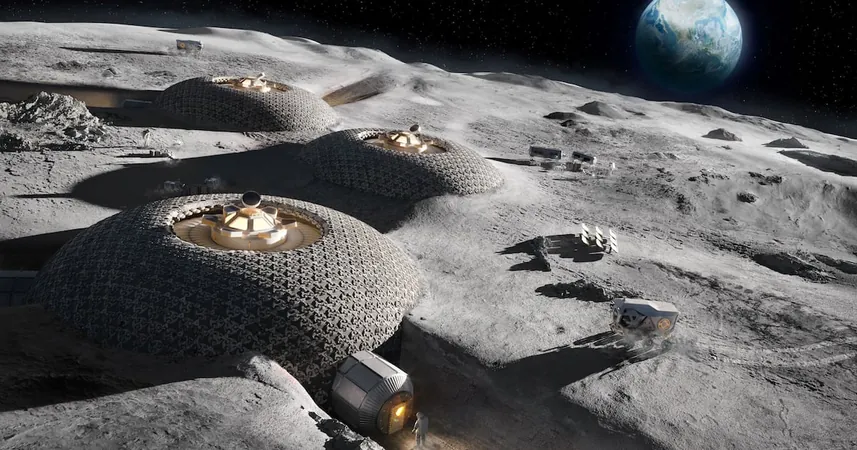
Building a Cosmic Future: What Lunar Designs Teach Us for Earth
2025-07-10
Author: Wei Ling
Exploring New Frontiers in Architecture
This year's Venice Architecture Biennale made waves with the groundbreaking Universe Pavilion, a visionary exhibition that delved into how we might inhabit space beyond our planet. Designed by top minds from the German and Italian space sectors, the pavilion challenged conventional national showcases, highlighting a bold idea: that the cosmos, much like climate change, transcends borders, and architecture could be our most powerful tool in addressing these universal challenges.
A Historic Moment for Space Architecture
The Venice Biennale is often hailed as the pinnacle of global architecture exhibitions, and the Universe Pavilion's debut marked a significant milestone, bringing the concept of space architecture into the spotlight. This high-profile platform underscores that future explorations into space are no longer just science fiction—they are becoming practical realities.
Lunar Living: Innovating Habitat Design
Among the influential voices in this emerging discipline are architects like Dr. Barbara Imhof, Michael Morris, and Orla Punch, whose work collectively charts the evolution of space architecture in Europe and beyond. Imhof's firm introduced the concept of "Building With and Living Off Lunar Resources," which focuses on crafting habitats on the Moon using solar-sintered lunar dust. This innovative method employs concentrated sunlight to transform lunar soil into solid building materials, allowing us to utilize local resources rather than transporting bulky materials from Earth.
Rethinking Survival in Space and Earth
Imhof emphasized that creating livable conditions in the harsh environment of space goes beyond mere survival; it necessitates a complete reconfiguration of our building approaches. She pointed out that while we might romanticize travel to the Moon due to the Apollo missions, significant challenges remain. "We have to start from scratch," she stated, reflecting the intricate nature of long-term human presence in space.
Contributions to the Gateway Project
Dr. Imhof is at the forefront of this field, co-founding Liquifer Systems Group and actively contributing to the European Space Agency's Gateway project—a lunar outpost designed to support deep space explorations. Set to launch in 2028 as part of NASA's Artemis program, the Gateway will feature the International Habitat (I-Hab), a compact living space for astronauts, and an Esprit module for refueling and communication.
Challenges Ahead for the Artemis Program
Despite the ambitious plans, uncertainties loom over the Artemis program amid changing political landscapes in the U.S. Imhof reflected on the precarious nature of funding, stating that shifts in policy could jeopardize essential components like the I-Hab. As she put it, "If politics keeps shifting, we won’t make it."
Lessons from Space for Earth’s Sustainability
The lessons derived from designing for extraterrestrial living have invaluable implications for sustainability on Earth, according to Imhof. She argues that to mitigate climate change, we must adopt strategies from space architecture—using local materials, reusing what we have, and minimizing our carbon footprints.
Storytelling and Survival through Design
Architect Michael Morris, along with his wife Yoshiko Sato, embodies this ethos with their firm, Morris Sato Studio, which focuses on habitat design for outer space. "Designing for space strips architecture back to a core question: how do we survive?" he said, highlighting the critical connections between creativity, climate issues, and the fundamental human need for shelter.
Rising Stars in Space Architecture
Emerging talents like Orla Punch are also making strides in this field. Her award-winning designs for Martian habitats during her student days have set her on a trajectory toward becoming a prominent voice in space architecture. At Foster+Partners, a leading global firm, she continues to blend earth-based designs with insights drawn from space concepts, demonstrating how aspirations for the cosmos can inspire innovations right here on Earth.
The Future of Architecture Knows No Bounds
The Universe Pavilion at the Venice Biennale stands as a testament to the burgeoning field of space architecture, igniting a conversation about our collective future. Its creators envision a time when such cosmic themes will be formally recognized alongside national exhibits, emphasizing the idea that space belongs to all of humanity. As we rethink our building practices through the lens of lunar and Martian projects, we may well find the keys to a more sustainable future on our own planet—before it’s too late.


 Brasil (PT)
Brasil (PT)
 Canada (EN)
Canada (EN)
 Chile (ES)
Chile (ES)
 Česko (CS)
Česko (CS)
 대한민국 (KO)
대한민국 (KO)
 España (ES)
España (ES)
 France (FR)
France (FR)
 Hong Kong (EN)
Hong Kong (EN)
 Italia (IT)
Italia (IT)
 日本 (JA)
日本 (JA)
 Magyarország (HU)
Magyarország (HU)
 Norge (NO)
Norge (NO)
 Polska (PL)
Polska (PL)
 Schweiz (DE)
Schweiz (DE)
 Singapore (EN)
Singapore (EN)
 Sverige (SV)
Sverige (SV)
 Suomi (FI)
Suomi (FI)
 Türkiye (TR)
Türkiye (TR)
 الإمارات العربية المتحدة (AR)
الإمارات العربية المتحدة (AR)